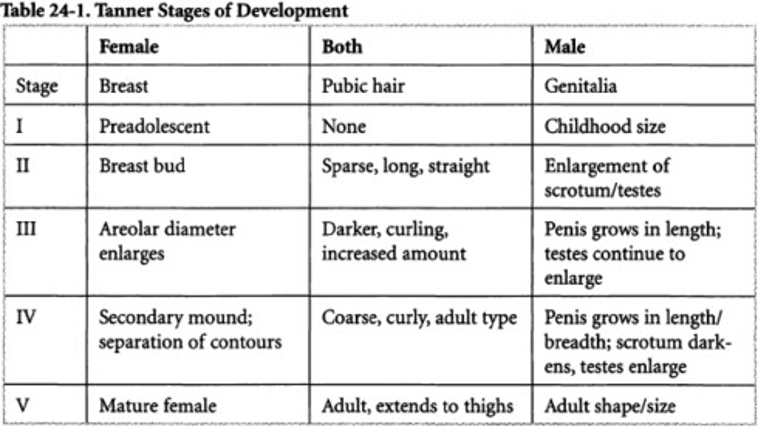The nurse is explaining Tanner staging to an adolescent and mother. Which statement best describes Tanner staging?
Staging of puberty based on the initiation of primary sexual characteristics
Predictable stages of puberty based on primary and secondary sexual characteristics
Staging of puberty based on the initiation of menarche and nocturnal emissions
Predictable stages of puberty that are based on chronologic age
The Correct Answer is B
The statement that best describes Tanner staging is option B. Tanner staging is a system used
to classify and assess the progression of puberty based on the development of both primary
and secondary sexual characteristics. It provides a framework for evaluating the physical
changes that occur during puberty, such as breast development in females, testicular
enlargement in males, pubic hair growth, and other secondary sexual characteristics. The
Tanner staging system includes several stages that represent the sequential progression of
puberty in individuals.
staging of puberty based on the initiation of primary sexual characteristics in (option A) is not
correct because it, does not encompass the full scope of Tanner staging, as it does not
consider the progression of secondary sexual characteristics.
staging of puberty based on the initiation of menarche (the onset of menstruation) and
nocturnal emissions, in (option C) is not correct. While menarche and nocturnal emissions are
significant events that occur during puberty, they do not encompass the entire Tanner staging
system, which involves a broader range of physical changes.
predictable stages of puberty based on chronologic age, in (option D) is not correct. Tanner
staging is based on the progression of physical changes and sexual maturation, rather than
being solely determined by chronological age. Puberty can vary in onset and duration among
individuals, making chronological age an unreliable indicator of pubertal development.

Nursing Test Bank
Naxlex Comprehensive Predictor Exams
Related Questions
Correct Answer is A
Explanation
In a teaching plan for the mother of an 11-year-old boy with ulcerative colitis, the nurse should stress the importance of coping with stress and avoiding triggers. Ulcerative colitis is a chronic inflammatory bowel disease that can be influenced by various factors, including stress and triggers. Helping the child and the family develop effective stress management strategies and identifying and avoiding triggers can help in reducing the frequency and severity of ulcerative colitis flare-ups.
preventing the spread of illness to others in (option B) is incorrect because it, is not the primary focus of teaching for ulcerative colitis. Ulcerative colitis is not an infectious condition that can be spread to others.
, nutritional guidance and supportive intake of sodas in (option C) is incorrect because it, is an important aspect of managing ulcerative colitis. However, it should be addressed in conjunction with a comprehensive nutritional plan that considers the individual needs and tolerances of the child. The mention of supportive intake of sodas may not be appropriate, as carbonated beverages can potentially aggravate symptoms in some individuals with ulcerative colitis.
teaching daily use of enemas in (option D) is incorrect because it, is not typically a part of routine care for ulcerative colitis in children. The use of enemas may be considered in specific situations or as part of an individualized treatment plan under the guidance of healthcare providers, but it is not a general teaching point for all children with ulcerative colitis.
Correct Answer is A
Explanation
The scenario describes a 14-year-old male who seems to be always eating, but his weight is appropriate for his height. In this case, it is important to reassure the parents that the behaviour may not necessarily be a cause for concern.
Option A provides an accurate response by explaining that for weight gain to occur, the individual would need to consume an excessive number of calories. Since the adolescent's weight is appropriate for his height, it suggests that his caloric intake is likely balanced and not excessive.
suggesting that he is substituting food for unfilled needs in (option B) is incorrect because it, is speculative and may not be accurate without further assessment or evidence. It is important to avoid making assumptions about underlying psychological or emotional reasons for increased eating without more information.
stating that this is normal due to an increase in body mass during this time in (option C) is incorrect because it, is not necessarily applicable to the scenario. While it is true that adolescents experience growth and changes in body composition during this period, it does not directly explain the constant eating behaviour described.
suggesting that this behaviour is abnormal and indicative of possible future obesity in (option D) is incorrect because it, may be premature and unsupported based solely on the information provided. It is essential to avoid making predictions or assumptions about future health outcomes without proper evaluation.
By providing the parents with information about the caloric intake required for weight gain and reassuring them that their son's eating behaviour may be within a normal range, the nurse can address their concerns and provide accurate guidance. If the parents have further concerned or questions, it may be appropriate to refer them to a healthcare provider for a more comprehensive assessment.
Whether you are a student looking to ace your exams or a practicing nurse seeking to enhance your expertise , our nursing education contents will empower you with the confidence and competence to make a difference in the lives of patients and become a respected leader in the healthcare field.
Visit Naxlex, invest in your future and unlock endless possibilities with our unparalleled nursing education contents today
Report Wrong Answer on the Current Question
Do you disagree with the answer? If yes, what is your expected answer? Explain.
Kindly be descriptive with the issue you are facing.
